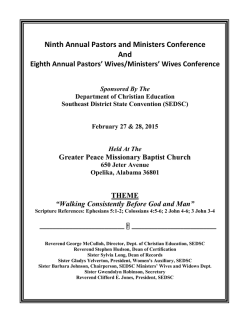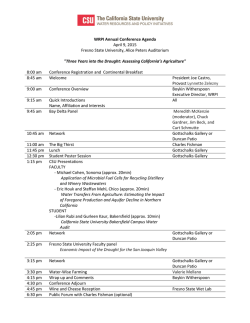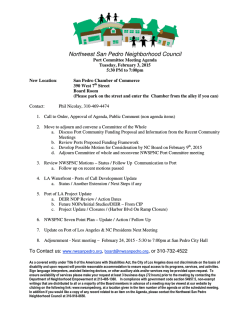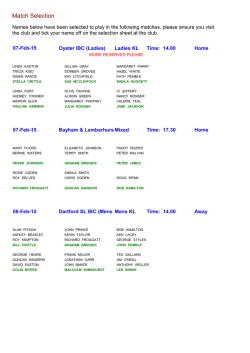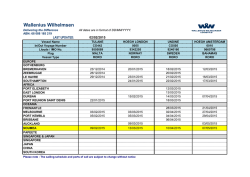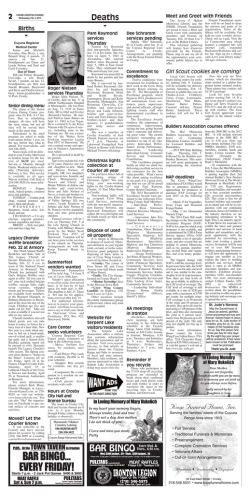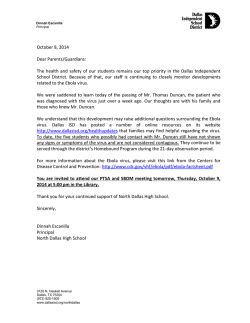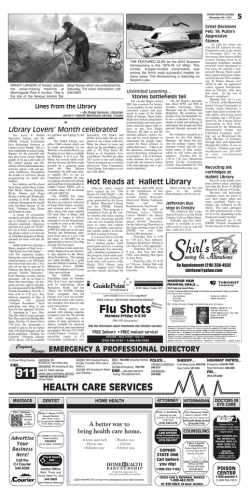
from ceremonial object to curio: object transformation at port
FROM CEREMONIAL OBJECT TO CURIO: OBJECT TRANSFORMATION AT PORT SIMPSON AND METLAKATLA, BRITISH COLUMBIA IN THE NINETEENTH CENTURY JOANNE MACDONALD R.R. #1 Cantley, Quebec J0X 1L0 ABSTRACT/RESUME This paper is an in-depth look at the collecting activities of the first two missionaries among the Coast Tsimshian, in the villages of Port Simpson and Metlakatla in the second half of the 19th century. Its primary focus is on the symbolic aspects of the cross cultural transaction by which Indian ceremonial objects were transformed into curios stored in museums in North America and Europe. L'article étudie en profondeur les activités d'accumulation des deux premiers missionnaires parmis les Tsimshian, dans les villages du Port-Simpson et de Metlakatla dans la seconde moitié du dixneuvième siècle. L'article souligne les aspects symboliques de la transaction interculturelle par laquelle les objets rituels des Indiens ont été transformés en bibelots conservés dans les musées en Amérique du Nord et en Europe. 194 Joanne MacDonald INTRODUCTION This paper is an in depth look at the collecting activities of the first two missionaries among the Coast Tsimshian in the villages of Port Simpson and Metlakatla in the second half of the nineteenth century. 1 It is also an examination of the possible motives of the Coast Tsimshian in giving up their ceremonial objects. The nineteenth century was a period when the growth of museums in North America and Europe validated the Euroamerican belief that Indians were vanishing. It was a period of active collecting on the Northwest Coast, a period for which the role of missionary as collector has hitherto been ignored.2 The starting point for this research was the museum catalogue data for two Tsimshian stone masks [Figure 1], one in the collection of the Canadian Museum of Civilization (V11-C-329) and the other in the Musee de l'Homme, Paris (81.22.1). The two stone masks were brought together by Wilson Duff for an exhibition Images Stone, B.C. (1975). It was Duff who discovered that the two masks fit together; until that time the two pieces were so similar it was thought they were from the hand of the same artist. The sighted mask in Paris was received there in 1881 and was collected from a Protestant missionary at the mouth of the Nass (Hamy, 1896:167). The general geographical description fits either Port Simpson or Metlakatla, which led to an exploration of the activities of the two missionaries of the time, William Duncan in both Port Simpson and Metlakatla, and the Reverend Thomas Crosby of Port Simpson. The unsighted mask was collected by Israel Wood Powell, the first Indian Commissioner for British Columbia, with a village attribution of Kitkatla. It was accessioned by the Geological survey of Canada in 1879 with no mention of missionary involvement.3 In order to provide a context for missionary collecting, data were obtained on all collectors for the period 1834 to 1950 at the two villages. The survey of catalogue data from 28 museums in North America and Europe, attributed 422 objects to Port Simpson and 121 to Metlakatla. 4 Missionaries collected or assisted in the collection of over 30 per cent of the total objects. As the stone masks are undoubtedly ceremonial in function, the data were further analyzed, revealing that approximately half of the ceremonial objects were collected by missionaries. Of the 104 ceremonial objects from Port Simpson, 56 were collected by missionaries, as were 13 of the 22 ceremonial objects from Metlakatla. These data include the role of missionary as middleman, providing a mail-order service for private nineteenth century collectors, such as British naval personnel, or for professional museum collectors. Recognizing that museum catalogue data present an uneven picture reflecting the lack of standardized terminology for description, and that From Ceremonial Object to Curio 195 196 Joanne MacDonald photographs are rarely available, object lists were compiled and divided into three categories: ceremonial, domestic and livelihood. The ceremonial objects are those belonging to chiefs and shamans; the domestic category included items for household use such as food utensils; and the livelihood category consists of hunting and fishing objects, including stone tools and weapons, plus models and sculptures produced for the tourist trade. It is likely that many domestic objects were also ceremonial as the pieces may actually be "named" dishes or spoons whose crest affiliation data were lost at the time on their removal from a community. The Indian perception of the activities of William Duncan, of the Church Missionary Society, and Reverend Thomas Crosby, representing the Methodist Church, led them to give their ceremonial regalia to the missionaries. Acknowledging the fact that the missionary documents describe Indian culture from a particular perspective, an attempt to provide the Indian viewpoint draws upon the recent research of Northwest Coast ethnographers of the Coast Tsimshian and Gitksan peoples. The missionary activities in Port Simpson and Metlakatla were documented from the time of the arrival of William Duncan in 1859, and Reverend Thomas Crosby in 1874. 5 William Duncan, a lay worker of the Church Missionary Society headquartered in England, arrived in Port Simpson unannounced. It appears that Admiral Prevost of the British navy had made recommendations that a missionary at the Hudson Bay post in the Indian village of Port Simpson would have beneficial long term effects on the trade. In 1862 Duncan moved his converts from the domination of the Hudson's Bay fort to the nearby old winter village of Metlakatla. He actually had advance notice of the spread of smallpox up the Coast and was able to move his people out of Port Simpson before the devastation hit the community. The fact that his Christian community avoided the great loss of life suffered at Port Simpson likely added to his prestige and to that of his religion. He stayed in Metlakatla until he moved his converts once again, to Annette Island, Alaska in 1881 (Figure 2). While there is a Duncan museum in New Metlakatla, there does not appear to be a personal collection made by him, nor did he ever pose in Indian regalia. The Chilkat blanket on the wall in the photograph is an item that was owned by high ranking chiefs. It is difficult to attribute objects collected by Duncan to a particular village as he drew converts from all the Coast Tsimshian communities, as well as from other northern villages. Reverend Thomas Crosby, on the other hand, was invited to Port Simpson in 1874 by Indian residents of the village who had met him in Victoria. Crosby was a Methodist evangelical, originally from Yorkshire, England, as was Duncan. He had previous missionary experience on the south coast of British Columbia. He carried on active mission work (as well From Ceremonial Object to Curio 197 Figure 2: William Duncan in his study, New Metlakatla, Alaska, between 1900 and 1905 as collecting) by mission ship along the north coast. His peripatetic ways, as well as a general sense of disillusionment with the benefits of Christianity, led to some community dissatisfaction with him. He was asked to leave in 1896 (Bolt, 1981:119). Just a few years after his arrival Crosby posed in chiefly regalia (Figure 3) with Sudalth (Victoria Young) of the Gispaloats tribe. The regalia became part of his personal collection. More recently they came (minus the headdress) into the collection of the Canadian Museum of Civilization. There is one other photo of Crosby taken in a studio dressed as a chief. It is likely these photos were taken for publicity to raise the profile of the mission field. Ceremonial Objects The ceremonial objects of the chiefs can be subsumed in the category of crest objects representing the corporate power of his or her House. The clans of the Coast Tsimshian are divided into a system of Houses and lineages. The House, or waab, was the basic social unit, composed of matrilineally related lineages (Seguin 1984:111). In contrast, the shaman's ceremonial objects represented individually attained power. Of the various types of shaman, healers, or swanesu, are most relevant is this study. They were gifted in soul retrieval, an important skill as soul loss was often considered a cause of illness. 198 Joanne MacDonald Crests can be seen as privileges founded on a myth; objects are one of the manifestations of that privilege. While it will be seen that chiefs parted with objects, these objects were only one aspect of the chief's power base. A chief could not part with the privilege upon which his power was based. When a chief displayed his objects, the mythology was recounted and the chief's right to these objects was validated at each telling. The objects thus functioned as symbols to both validate and perpetuate the prevailing social order. Crests were a form of public art, ranging from architectural features, such as totem poles and house fronts, to items worn and used by chiefs at potlatches. Some objects associated with chiefs, such as raven rattles and coppers, are not considered crest items (Halpin 1984:21). From museum records, it appears that the early explorers and traders were able to acquire the prestigious raven rattles (non-crest items) in the pre-missionary period, while crest objects were not available. The ceremonial objects received by explorers such as Captain Cook were likely given in recognition of the unique appearance of the sailors and their ships. Coast Tsimshian chiefs and House members also had naxnox powers which were interpreted in many physical forms, of which masks were the most common. The stone masks are likely naxnox. The naxnox powers were not on permanent display and were made in secret by the Gitsonk artists. Adams (1973:41) explained that for the Gitksan A naxnox is both a particular spirit whose power the owner of the name is supposed to inherit when he takes the name and...also a "show" or dramatization of the power of that spirit. Chiefs were also the central power figures in the secret societies, a role in which they may have been confused with shamans by casual observers. In this role, chiefs wore cedar bark head and neck rings, carried a skull rattle, and were accompanied by a wood drum and whistles (Guedon 1984:158-159). The acquisition of chiefly objects covered a broad spectrum of social roles, so that the limitations placed upon the chiefs in these areas effectively put more power into the hands of the missionaries. From Ceremonial Object to Curio 199 Figure 3: Reverend Thomas Crosby with Sudalth at Port Simpson around 1876. 200 Joanne MacDonald THE TREATMENT OF POWER OBJECTS IN INDIAN CULTURE Not all objects were given up to the missionaries. Some high ranking people chose the option of burning them. While there are recorded instances of missionaries actively seeking objects for the fire6 there are instances of the burning of objects reported by missionaries which do not appear to have been instigated by them. The Native missionary Reverend William Pierce (1933:26) recorded an incident at Bella Coola in 1885. He described how the boxes of ceremonial items "that had been handed down for generations" were put on the fire at midnight. Included was a special whistle for which the owner's grandfather had been offered a slave. His grandfather had rejected the proposition as it was "against the rules to sell at any price." A burning of objects at Kitwanga on the upper Skeena River reported by the missionary Reverend Price may have been in response to the Federal government's declaration of the potlatch as an illegal activity in the 1884 Indian Act. Price reported that the Christians decided without consulting the missionary "to burn their heathen regalia and paraphernalia." Amongst many people of the Northwest Coast there appears to have been the belief that the power of objects could be transferred to the spirit world by smoke. Duff (1959:16) described the sending of the spirit of a supernatural box in the village of Kitwankool. It was held over the fire while the object itself was unharmed. Garfield reported that a Port Simpson shaman sent objects to the recently dead by throwing them in the fire, while an audience watched. The transfer of the spirit of the objects by fire may account for some of the cases of voluntary destruction described earlier. Malevolent objects were not burnt but sunk in the sea (Large, 1968:76). The sea was also the repository for objects that could not be burned, such as Coppers. Property distribution in the traditional society was the source of many conflicts. The Hudson's Bay Company records describe particular incidents when bloodshed occurred. Following the death of a chief, his or her material wealth was distributed at a memorial feast. "Much of the wealth in the possession of a chief came from his tribe and the influential men often dictated the deposition to be made of wealth they had helped to accumulate" (Garfield, 1939:264). It should be noted that an elderly informant in Port Simpson in 1979 identified the stone masks (from photos) as a source of much trouble in the village of Port Simpson. The action of a successor chief giving away the objects of this predecessor provides some insight into the Aboriginal perception of these goods. Seguin (1984:118) has referred to this action as "emptying the house." She suggests that in the memorial feast context the high ranking From Ceremonial Object to Curio 201 guests of the host may be viewed as "Real Beings from other Worlds." By giving away property to the other side (i.e. guests), the new nameholder returns goods to the supernatural realm which then allows the supernaturals to respond with more wealth through the conduit of the new chief. Perhaps Duncan and Crosby were able to tap into this concept when they were perceived as the sources of the new "White" power. Duncan's Collecting One of Duncan's first acts in Port Simpson involved plugging into the curio market as he raised money to build a school through the sale of "baskets, carved spoons and dishes for the native curio market in Victoria" (Arctander, 1909:149).7 The first incident we know of Duncan collecting objects for sale directly to collectors occurred at the same time as the first baptism ceremony in Metlakatla in 1863. Because he was not ordained, he hosted Bishop Hills and Reverend Dundas to undertake the task. Reverend Dundas had written to Duncan in advance asking him to make a selection of objects for him. The 80 pieces chosen are still with Dundas family descendants in England.8 Duncan wrote in the Church Missionary Society's publication the Gleaner (1881): The instruments of the medicine-men which have spell-bound their nations for ages have found their way into my house and are most willingly and cheerfully given up. While Duncan, no doubt, was engaging in missionary rhetoric, his correspondence indicates he offered for sale at least 59 pieces while at Metlakatla, 2 of which related to shaman regalia and 9 to chiefs. Duncan maintained an active mail-order business in curios. A letter of enquiry to Duncan in 1872 from Captain Cator of H.M.S. Scout stated ...I should be obliged if you would firstly collect from the Indians anything that you might be able to pick up from them-stone chisels and hammers, men's headdresses (squared cap) and woman's [word unclear] (letter, Cator to Duncan, February 2, 1872:NAC). Other correspondents for specific curios included Judge Begbie and Dr. Ash. The description that accompanied a stone bowl sent to Dr. Ash (possibly the Victoria parliamentarian), indicates the level of the missionary's knowledge: 202 Joanne MacDonald It [the stone bowl] was used for preparing the quid taken by the Chief before retiring to bed. The quids were made from a plant which is found on the Queen Charlotte Islands and were a luxury which all the head people indulged in previous to the introduction of tobacco. These stone bowls are now very scarce and therefore dear (letter, Duncan to Ash, October 11, 1875:NAC) Duncan on occasion sent off lists of pieces he had available for sale. In 1878 he wrote Lieutenant Fritz H.E. Crowe of the Shah, which was stationed at Esquimalt, offering 20 objects for sale. On the list is a "stone face" which Duncan described as representing "The Thief", priced at $15.00. A footnote at the bottom of the page added "Mr. Neil [name unclear] bought last year the fellow of the carved stone face (first item) and he was wanting to buy the one I got but was too late" (letter, Duncan to Mr. Englehardt, August 6, 1878:NAC). With this footnote Duncan shed light on two great museological mysteries. He brought the famous Tsimshian twin stone masks closer to their original context (see Figure 1). This footnote implies that Duncan had this piece for more than a year and that he likely bought it from the original owner. The location of the owner is still unknown, though certain stylistic features tie the stone masks closely to other masks collected from Port Simpson. No correspondence was found linking the Paris mask to its collector, the French explorer Alphonse Pinart. Duncan's identification of the face as belonging to the "Thief" is likely a reference to the myth of the Raven who stole the Sun. In the ceremonial village context they would likely have been used in a naxnox performance where the audience would expect that there was only one mask, as the unsighted outer masks fits perfectly over the inner sighted mask. A dancer could remove one under the cover of a dance blanket. The success of Duncan's Christian village of Metlakatla, with its row houses similar to those in his birth place of Beverly, in England, and huge Native built church, gained international recognition and attracted many distinguished visitors. During the 1876 visit of Governor-General and Lady Dufferin, Duncan presented them with silver bracelets, silver napkin rings and furs. Duncan expressed surprise when the Indians on their own initiative gave the royal visitors a mask and a woven cedar hat with segmented portions (likely a chief's dancing hat). Although Duncan had known the donor of the hat for years, he had never seen it before (Dufferin, 1891:265). This incident underlines another aspect of coastal Indian life. Ceremonial objects were kept hidden away and neighbours might not know what objects were held by those living next door. It should be noted that Duncan had prohibited the potlatch in Metlakatla, so Christian chiefs had no occasion on which to wear their regalia. Duncan, however was not opposed to the representation of traditional art. When outlining the history of the various industries established at Metlakatla, Duncan noted "I am encouraging the Indians to From Ceremonial Object to Curio 203 keep their ancient carving and our village Hall (now being erected) is to be almost entirely Indian in style and structure" (Letterbook, Duncan to the CMS, August 13, 1881:NAC). Duncan supported the phratry system which he perceived as unifying the people from the various villages. The first chapel at Metlakatla had two carved support beams representing the four phratries of the Coast Tsimshian (Figure 4). Duncan encouraged other traditional crafts such as hat making, "which might find a market locally or as curios in Victoria" (Usher, 1968:301). This survey of Duncan's collecting is likely incomplete as he dealt directly with many people who visited his mission. He was not involved in selling totem poles as there were none standing at the old village site of Metlakatla. It appears that his curio dealing subsided after 1879 as he became involved in internal conflicts with his sponsors, the Church Missionary Society.9 The circumstances under which the missionaries acquired the objects is poorly documented. We do not know if the Indians received money from the sale of their objects. It is likely that the funds were recycled into local mission projects. Crosby's Collecting Reverend Thomas Crosby was invited to Port Simpson in 1874, possibly as a retaliation gesture by a Port Simpson chief against Duncan (Beynon, 1941:86). At the time of his arrival the populations of Port Simpson and Metlakatla were each about 800. Within one year of his arrival Crosby had 12 full church members and 100 on trial (Bolt, 1981:196). At one point Crosby (1914:66) organized an Indian Council in which the law enforcing committee, with a chief at its head, would go: to the houses and take away the medicine-man's rattles and charms...Of course this made some of the old conjurers and gamblers very angry, but when they were told that they or their friends had helped to make the laws, they quietly submitted. Contrary to the impression given above, the bulk of Crosby's collecting, like that of Duncan, was from the chiefs. Crosby's collecting was more comprehensive than was Duncan's, both personally and in his role as middleman. Shortly after Crosby's arrival in Port Simpson, James G. Swan, the first professional museum collector on the Northwest Coast representing the Smithsonian Institution, contacted him. Duncan was away in Ottawa at the time. 204 Joanne MacDonald Figure 4: Chapel Interior with carved phratry support posts in non-traditional style. Metlakatla, British Columbia. From Ceremonial Object to Curio 205 Crosby, assisted locally by Charles Morrison, the Hudson's Bay Company chief trader and his wife Odelia Morrison, pulled together a collection of 59 Port Simpson pieces destined for the Philadelphia Centennial Exhibition of 1876. Swan was delighted to acquire house boards "the only ones he could obtain at any price." They portrayed the crest of the "salt water bear in the centre doorway and Killerwhales on each side" (Cole, 1984:109). Port Simpson was famous for its painted housefronts (MacDonald, 1984:109) and their replacement with European style houses caused anguish to other collectors.10 In 1881, Adrian Jacobsen, while collecting for the Berlin Museum, noted that Port Simpson was "the first Indian village in which I bought nothing because there was nothing to obtain" (Jacobsen, 1977:28). It should be noted that the destruction of the old style houses put people into debt as they replaced the traditional houses with sawn lumber, glass windows and imported hardware. It seems odd that Jacobsen did not mention a "sort of museum" described by Swan, in which Crosby and Morrison had collected a number of totem poles (Morris, 1879:145). Although Crosby left no record of his attitude toward totem poles he did note that one of his first converts "..had his crest pole taken down, burned his house and built a new one" (Missionary Outlook, Vol. 11, January 1882). The pole "taken down" may have been put in the "museum" which may have been where Swan selected his totem poles. Swan collected two exterior poles from Port Simpson in 1875 after travelling as far as Alaska in his search. He found that the Alaska Natives "asked the most fabulous prices for their carvings" (letter, Swan to Commissioner Indian Affairs, October 11, 1875:SIA). He later learned the prices reflected the amount of wealth distributed at the time of the pole raising. It is certainly clear that no totem poles were collected from the Northwest Coast in the pre-missionary period. In 1887, two interior poles of a sub chief of the Kit-spah-lots (Gispaloats) were shipped via R.H. Hall, a Hudson's Bay Company employee at Alert Bay, to the Pitt Rivers Museum in Oxford, England. It is likely that either Crosby or Reverend Raley (his successor) was involved in these arrangements. The strategy of collecting was described by Swan, in which the objects were removed from the house of one chief to that of another. His Haida contact, "Johnny" told people that "I send these things to the great Chief of the Boston [American] people, who have them taken care of and preserved in a big house" (letter, Swan to Baird, May 22, 1887:SIA). Crosby collected actively in his travels on his mission ship up and down the coast and to the Queen Charlotte Islands. The bulk of his private collection of 253 pieces he sold to the Museum of the American Indian in New York in 1908. Eighteen pieces were from Port Simpson. In spite of his high interest in collecting, Crosby-unlike Duncan-did not 206 Joanne MacDonald encourage the traditional wood carving crafts. The lack of encouragement of artistic endeavour was reflected in the 1881 census. There were no artists listed at Port Simpson (Fred Alexcee must have been missed) though silversmiths, matmakers and a sculptor were resident in Metlakatla (Reel C13284:NAC). The carving activities of the traditional craftsmen (in the non-Christian half of the Port Simpson population) would not have been recorded. Figure 5: Baptismal Font from Port Simpson From Ceremonial Object to Curio 207 There is one unique piece from the Port Simpson church, a baptismal font carved in the form of an Indian angel by the Port Simpson artist Fred Alexcee (Figure 5). It was removed by Crosby's successor Reverend Raley, also an avid collector, because it frightened the children (Raley Collector Notes: Museum of Anthropology, University of British Columbia). Indian View of White Power The records suggest that Duncan and Crosby, both fluent Coast Tsimshian speakers, were perceived by their Indian converts as combining the qualities of chiefs, shamans and supernaturals. The missionaries themselves admitted that they felt in competition with the medicine-men or shamans in the areas where they overlapped in health care. Duncan was critical of the speed with which Crosby baptized his converts; "He did not know (perhaps he did not care to know) that the Indians were seeking baptism from his hand to act as a charm for their bodily preservation" (Letter, Duncan to Church Missionary society, March 29, 1876:USFAS). It should be noted that both men did arrange for medical doctors to come to their communities at their own expense. The shaman image continued on with Bishop Ridley who replaced Duncan at Metlakatla. He wrote "I am known for hundred of miles as a medicine-man" (Ridley, 1903:58). Reverend James McCullagh, the Anglican missionary among the Nisga'a on the Nass River dressed as a shaman for the cover of his book "McCullagh of Aiyansh" (Moeran:1923). A group of Tlingit Indians visiting Metlakatla met Duncan in his work clothes and exclaimed: "Surely you cannot be the man! Why we expected to see a great and powerful giant, gifted in magic, with enormous eyes that could look right through us and read our thoughts!" (Davis, 1904:75). Although Duncan claimed to abhor the tendency to attribute powers to the missionary, nonetheless his stated strategy implied otherwise, as he explained to a group of Indian Commissioners in Washington that he told an Indian "I had a message from God who made him, he instantly began to pause and think and wanted to know about the message" (Wellcome, 1887:388). He also used various developments in Western technology to impress his converts. Duncan referred to the Bible as "God's Letter" and it may have been perceived by Indians as a naxnox power. Reverend A.E. Green, the Methodist missionary on the Nass River, reported the case of a dying Nisga'a chief who tied his Bible to a stake as a source of inspiration (Missionary Notice, May 1878:296). The ability to read and write was the most tangible of the European powers offered to Indians. Both the missionaries and the chiefs controlled access to the schools. Reverend Pierce reported that he had to leave Duncan's school on the order of his chief (Pierce, 1933:11). One of the reasons Duncan chose to move to Metlakatla was to put "the school operation on a more satisfactory footing 208 Joanne MacDonald as the imparting of secular knowledge would thus be limited to those who had embraced the Gospel" (Johnson, 1875:135). The image of Europeans in the role of chiefs quickly penetrated the traditional view of the afterlife. Reverend A.E. Green reported that a woman "on her death bed saw what appeared to be four White women, who had come to carry her to her son (deceased), on the other side of the river" (Christian Guardian: July 7, 1890). The documentation of the Native perception of Crosby is not extensive. There is, however, the record of the villagers' complaint that he never stayed at home (Bolt, 1981). Cove (1987:231) has pointed out that immobility is a major feature of Tsimshian chiefs. Disillusionment set in at the end of Crosby's tenure at Port Simpson. The Indians had put all their money into village improvements and expected that there would be more help from the Methodist Church. They complained to the Methodist officials about their situation in 1885 (Bolt, 1981:119). Ideological preconceptions of the caretaker role of the missionary-chief may have contributed to this despondency. It is likely that prior to the ritual of baptism people gave up their traditional objects and that the traditional regalia would have been replaced with purchased "White" clothing. The description of a feast in Port Simpson in 1884 describes the host chief's high beaver hat and black coat with silver buttons (Hendry Letterbook:PABC). Baptism was highlighted with the taking on of a new Christian name and would be syncretic with the acquisition of new names in the traditional system. The emotion that surrounded baptism was described by Reverend Dundas at Metlakatla in 1863: Mr. Duncan called up each by his heathen name. In answer to my request "Name this person" he gave the new Christian name, and by it I baptized the candidate. "As I held the hand of each while receiving him or her into the Church of Christ and signing him with the sign of the Cross, I could often feel that they trembled with deep emotion (Wellcome, 1887:79). Duncan is also recorded as bestowing names as Christmas presents on his Port Simpson students (Garfield, 1939:225). A study of the names given by missionaries would reflect much of late nineteenth century social history immortalized on the Northwest Coast. Seguin has pointed out that it is not known whether the domain of Christian names was kept distinct from that of Tsimshian names. It should be noted that the House names continued on and were not lost. The members' of a House can be thought of as the ranked names, not the individuals who filled the names at any point in time (Seguin, 1984:111). From Ceremonial Object to Curio 209 An example of the continuity of object naming was recorded by Boas. He reported attending a Kwagiulth feast in 1930 where the host described the appearance of each serving dish for his guests. "This bowl in the shape of a bear is for you, for each group a bowl." Boas noted "But the bowls are no longer there. They are in the Museums of New York and Berlin" (Rohner, 1967:297). CONCLUSION By the turn of the century, the bulk of the traditional objects were removed from the village of Port Simpson.11 Garfield reported the preparation of Chief Nelson's Cornet Band for the visit of the Duke of York in 1901: "Having none of the traditional ceremonial garments to wear, they made Chilkat blankets and leggings from canvas and Mr. Alexcee painted the designs on them" (Garfield Archives, Box 2, File 2, University of Washington) (Figure 6). Burridge (1969:7) wrote that "...religious activities will change when the assumptions about the nature of power, and hence the rules that govern its use and control, can no longer guarantee the truth of things." The ceremonial objects in museums provide data by which to assess the Coast Tsimshian "assumptions about the nature of power." The objects document a shift in the perceptions of the localizations and medium of power. The ceremonial objects of both the chiefs and shaman would not have been transformed by the missionaries into curios without the Indian perception of the shift in the power base. There was the shift in the role of the power-holder from the chief and shaman to the missionary. The giving up of ceremonial objects was tied in with the building of European style houses and the adoption of White clothing and White foods.12 The museum sample, while in no way documenting all the objects removed from Port Simpson and Metlakatla, indicates that more ceremonial objects were acquired by missionaries than by anyone else. While this study has not examined the role of coercion in the transformation of ceremonial objects to curios, it was implicit in the late nineteenth century on the Northwest Coast. Coercion was subtle; its influence started with the first European diseases, which the missionaries later exploited as God showing his strength, to the actual physical domination of gun boats on the Northwest Coast. Though most of the missionary collecting took place prior to the 1884 amendment to the Indian Act which prohibited the potlatch and certain Northwest Coast dances, the pressure of the authority of the dominant culture was already in place. The "giving-up" of the crest objects may be a particular indicator of the role of the chiefs as an adaptation strategy to the White power order. Perhaps the "emptying of the House" at the succession of a new chief in the traditional system made it easier for the chiefs to meet the demands of Joanne MacDonald 210 the new religion. It can also be observed that by giving up their crest objects (or destroying them) the Indians were making a deeper commitment to Christianity than previously expected. Seguin (1985:96) has noted that, Incorporation of Christianity into their system by the Tsimshian did not diminish their conviction that they owned their territories; in general the missionaries became persuaded of the legitimacy of native title. The presentation of the Allied Tsimshian Tribe's land claim to the Federal government in 1982 is tangible evidence that the oral tradition of the House histories and their relations to the territories continued. Figure 6: Cheif Nelson’s Cornet Band, 1901. From Ceremonial Object to Curio 211 In the broader context of the colonial experience as described by Patterson (1972:7), it may be that the removal or destruction of the traditional material culture of the converts, especially the objects belonging to their traditional power brokers, may be taken as another predictable event in the Christianizing/civilizing process. This is a process which is viewed as secular on one side and religious on the other, as ceremonial objects are transformed into curios in the dominant culture. NOTES 1. An earlier version of the paper was presented at the 1987 Hartley Bay Conference, Hartley Bay, British Columbia. The following abbreviations are used in the text and notes for archival materials: CCFCS: Canadian Centre for Folk Culture Studies, Canadian Museum of Civilization, Barbeau Archives. CMC: Canadian Museum of Civilization NAC: National Archives of Canada SIA: Smithsonian Institution Archives USFAS: United States Federal Archives, Federal Records Centre, Seattle 2. Cole (1985) does not deal with the role of the missionary as collector. Museum catalogues were the primary source for this data. Other Northwest Coast missionary collectors included Reverend W. H. Collison, Dr. R.W. Large, Bishop Lemmens, Reverend J.B. McCullogh, Reverend George Raley, and Bishop Ridley. Large's collection was described by Black (1989). 3. The accuracy of I.W. Powell's collector notes of his 1879 trip are highly questionable. He attributed the stone mask to Kitkatla, though he did not visit the village on this trip. He could have been told the mask was from there. Interviews with elders in the summer of 1979 at Port Simpson, Metlakatla and Kitkatla provided evidence indicating the original owner was Chief Nies-toix with tribal affiliations to the Gitwilgeots and Ginaxongik of Port Simpson (MacDonald, 1979). 4. The list of museums contacted for the study, plus the object list, is available on microfiche from Carleton University, Ottawa as an M. A. thesis (MacDonald, 1985). 5. William Duncan's work at Metlakatla has been extensively documented by admirers of his brand of Victorian Christianity. The most comprehensive and objective study is that of Usher (1974). Joanne MacDonald 212 Reverend Thomas Crosby wrote two books, in 1907 and 1914. Bolt (1981) provides an historical perspective on Crosby. 6. Father Morice, working with the Carrier Indians of the Upper Skeena River in 1905, actively encouraged his converts to bring out their regalia for burning (CCFCS:B.F. 321). 7. In 1885, George Edgar, the Native missionary at Gold Harbour on the Queen Charlotte Islands, received ceremonial objects to sell to assist in the building of the church (Crosby, 1914:268). Crosby reported (ibid:271) that the residents of Clue also "gave liberally of ..chief 's costumes coppers and blankets towards the building of the church." 8. If the collection of Reverend Dundas had been included, it would have more than doubled Duncan's figures. Eighty pieces were acquired by Dundas from Duncan on October 26, 1863 (letter, Carey to Maranda, March 4, 1980, Vancouver Museum). 9. Dr. Viola Garfield collected two well documented boxes from new Metlakatla in the early 1930's. These boxes, now in the Thomas Burke Museum, Seattle, were likely used in the 1881 move. 10. Though the population of Port Simpson was never more than half Christian (Bolt, 1981:114), it is interesting that all the houses were converted to European style during Crosby's tenure. 11. Garfield's comment ignores the fact that only high ranking chiefs would have owned a Chilkat blanket. Dr. Marius Barbeau collected 267 objects (mostly basketry) from Port Simpson in the winter of 1915. He noted there were "many fine specimens here, but expensive, such as large coppers, carvings and blankets" (Barbeau letters, CMC). He did purchase a 40 year old Chilkat blanket, "the finest of its kind" at that time. 12. The term "White" is used here in its Nineteenth century sense; the implied Victorian supremacy of things "White." REFERENCES Adams, John 1973 The Gitksan Potlatch: Population Flux, Resource Ownership and Reciprocity. Toronto: Holt, Rinehard and Winston. From Ceremonial Object to Curio 213 Arctander, John W. 1909 The Apostle of Alaska: The Story of William Duncan of Metlakatla. New York: Fleming H. Revell Company. Beynon, William 1941 The Tsimshian of Metlakatla, Alaska. American Anthropologist 43:83-88. Black, Martha 1989 Looking for Bella Bella: The R.W. Large Collection and Heiltsuk Art History. The Canadian Journal of Native Studies 9:273-292. Bolt, Clarence 1981 Thomas Crosby and the Tsimshian of Port Simpson 18741897. Master of Arts Thesis. Simon Fraser University, Burnaby, B.C. Burridge, Kenelm 1969 New Heaven New Earth. Oxford: Basil Blackwell. Christian Guardian, Methodist paper, United Church of Canada Archives, Victoria University, Toronto. Cole, Douglas 1984 But the Bowls are No Longer There: Museums, Expositions2 and the Artifacts of the Northwest Coast. Manuscript quoted with author's permission. 1985 Captured Heritage: The Scramble for Northwest Coast Artifacts Seattle: University of Washington Press. Cove, John J. 1987 Shattered Images: Tsimshian Mythological Conceptions of Being Human. Ottawa: Carleton University Press. Crosby, Reverend Thomas 1914 Up and Down the North Pacific Coast by Canoe and Mission Ship. Toronto: Missionary Society of the Methodist Church. 1907 Among the An-Ko-me-nums of the Pacific Coast. Toronto: William Briggs. 214 Joanne MacDonald Davis, George T.B. 1904 Metlakatla: A True Narrative of the Red Man. Chicago: The Ram's Horn Company. Duff, Wilson 1959 Histories, Territories and Laws of the Kitwankool. Anthropology in British Columbia, Memoir 4. Victoria: Provincial Museum of British Columbia. 1975 Images Stone B.C.: Thirty Centuries of Northwest Coast Indian Sculpture. Toronto: Oxford University Press. Dufferin, Marchioness 1891 My Canadian Journal 1872-78. London: John Murray Duncan, William 1871/83Letterbooks and letters received. Reels M2315, M2317, M2321. National Archives of Canada. Garfield, Viola 1939 Tsimshian Clan and Society. Seattle: University of Washington Press. Gleaner, publication of the Church Missionary Society. Synod Archives, Toronto and Vancouver Theology School. Guedon, Marie-Francoise 1984 An Introduction to Tsimshian World View and its Practitioners, pp. 137-159 in Margaret Seguin (Editor): The Tsimshian, Images of the Past: Views for the Present. Vancouver: University of British Columbia Press. Halpin, Marjorie 1984 The Structure of Tsimshian Totemism, pp. 16-35 in Jay Miller and Carol M. Eastman (Editors): The Tsimshian and Their Neighbours. Seattle and London: University of Washington Press. Hamy, E.T. 1896 Note Sur Un Masque en Pierre des Indiens de la Rivière Nass, Columbie Britannique. Journal de la Societe des Americanistes de Paris, Tome 1: 167-170. From Ceremonial Object to Curio 215 Jacobsen, Johan Adrian 1977 Alaska Voyage 1881-1883, An Expedition to the Northwest Coast of America. Translated by Erna Gunther. Chicago and London: University of Chicago Press. Johnson, M.E. 1875 Dayspring in the Far West: Sketches of Mission Work in Northwest America. London: Sealey, Jackson and Halliday. Large, R. Geddes 1968 Drums and Scalpel: From Native Healers to Physicians on the North Pacific Coast. Vancouver: Mitchell Press. MacDonald, George F. 1984 Painted Houses and Woven Blankets; Symbols of Wealth in Tsimshian Art and Myth, pp. 109-136 in Jay Miller and Carol M. Eastman (Editors): The Tsimshian and Their Neighbours. Seattle University of Washington Press. MacDonald, Joanne Rice 1979 Report on file, "Changing Faces of Stone", Canadian Ethnology Service, Canadian Museum of Civilization, November 16, 1979. 1985 From Ceremonial Objects to Curios: Power Exchange at Port Simpson and Metlakatla. Master of Arts Thesis, Carleton University, Ottawa, Ontario. Missionary Outlook, United Church of Canada Archives, Victoria University, Toronto. Moeran, J.W.W. 1923 McCullagh of Aiyansh. London: Marshall Brothers. Morris, William G. 1879 Report upon the Resources of Alaska Territory, 45th Congress, 3rd Session, Senate Executive Document, Washington, D.C. pp. 43-150. Patterson, E. Palmer 1972 The Canadian Indian: A History Since 1500. Don Mills: CollierMacMillan Canada Ltd. Pierce, Edward Henry 1933 Potlatch to Pulpit. Vancouver: Vancouver Bindery ltd. Joanne MacDonald 216 Ridley, William 1903 Snapshots from the North Pacific. London: Church Missionary Society. Rohner, Ronald 1967 The Ethnography of Franz Boas: Letters and Diaries of Franz Boas Written on the Northwest Coast from 1886-1931. Chicago: University of British Columbia Press. Seguin, Margaret 1984 Lest There Be No Salmon: Symbols in Traditional Tsimshian Potlatch, pp. 110-133 in Margaret Seguin (Editor): The Tsimshian, Images of the Past: Views for the Present. Vancouver: University of British Columbia Press. 1985 Interpretive Contexts for Traditional and Current Coast Tsimshian Feasts. Mercury Series 98. Canadian Ethnology Service. National Museum of Man. Usher, Jean 1968 Duncan of Metlakatla: The Victorian Origins of a Model Indian Community, pp. 286-310 in W. L. Morton (Editor): The Shield of Achilles. Toronto: McClelland and Stewart. 1974 William Duncan of Metlakatla: A Victorian Missionary in British Columbia . Ottawa: National Museum of Canada. Wellcome, H.S. 1887 The Story of Metlakatla. London: Saxon and Co. FIGURES 1. Tsimshian stone masks photographed for the exhibition Images Stone B.C. Wilson Duff, Museum of Anthropology, University of British Columbia. 2. William Duncan in his study, New Metlakatla, Alaska, between 1900 and 1905. Garfield Album, University of Washington, Negative 3083. 3. Reverend Thomas Crosby with Sudalth at Port Simpson around 1876. Royal British Columbia Museum, PN 4191. 4. Chapel Interior with carved phratry support posts, in non-traditional style. Metlakatla, British Columbia. Canadian Museum of Civilization, negative 71-4292. From Ceremonial Object to Curio 217 5. Baptismal font from Port Simpson. Raley Collection, Museum of Anthropology, University of British Columbia. 6. Chief Nelson's Cornet Band, 1901. Vancouver Public Library, Neg. 9411.
© Copyright 2025
